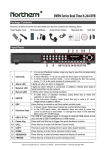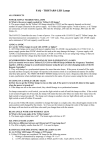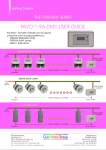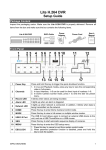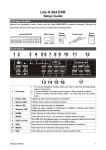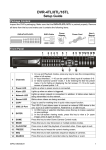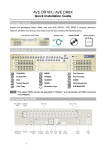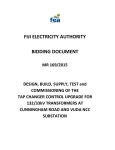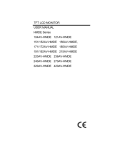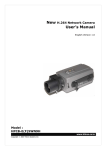Download FAQ_TRISTAR-MASTER-SLAVE_Lamps 1.8
Transcript
FAQ – TRISTAR® MASTER-SLAVE LAMPS POWER SUPPLY NEEDED FOR LAMPS Q. What is the power supply needed for TRISTAR LED lamps? A. The power supply for the TRISTAR LED lamps should be 12VDC and the capacity depends on the total number of lamps connected to the power supply. All TriStar LED lamps require 5 watts of power, so if 5 lamps are connected, 25 watts would be required, 100 watts for 20 lamps, 250 watts for 50 lamps, 500 watts for 100 lamps, etc. However, the power supply should ideally be increased by at least 10~20% to account for voltage drops. The PAVO-96-DMX Controller also uses 5 watts of power. For a system with 1 PAVO-96-DMX and 32 TRISTAR-SLAVE Lamps, the total maximum power consumption is: 5 watts x 33 = 165 watts. Thus, any power supply with 12VDC output and a minimum of 165 watt capacity could be used, but as mentioned above, an additional 10~20% of powers supply is recommended. (The PAVO-96-DMX Controller can accept up to 96 devices.) ELECTRONIC AND MECHANICAL WIRE WOUND TRANSFORMERS Q. Can the TRISTAR-SLAVE lamps be used with both electronic and mechanical wire wound transformers? A. There are no problems in using the 5watt LED lamps with mechanical wire wound transformers. Just remember that each lamp requires 5 watts of power. Electronic type transformers, however, can sometimes be unstable. We’ve been able to use electronic transformers 95% of the time, but they are not successful 5% of the time. So we recommend a trial and error approach. The lamps will not be harmed in any way. If you need to replace an electronic transformer, we recommend using a 12VDC LED power supply. MAXIMUM DISTANCE OF CONNECTION AND DISTANCE BETWEEN LAMPS Q. What is the maximum distance that TRISTAR-SLAVE lamps can be connected? A. The maximum distance that can be used with the TRISTAR-MASTER/SLAVE lamps is 70 meters, after which you can add the PAVO-REPEATER to add another 32 TRISTAR-SLAVE lamps and an additional power supply. It doesn’t matter how close the lamps are to each other within the range of 70 meters.. MAXIMUM DISTANCE FROM POWER SUPPLY TO THE LAST LAMP Q. What is the maximum distance between the power supply and the last TRISTAR-SLAVE lamp? A. It is difficult to say what the maximum distance from the power supply to the last TRISTARMASTER/SLAVE lamps should be. The constraint would be the voltage drop due to a long distance cable run. The rate of voltage drop depends on the wire gauge. Large wire gauge will result in less voltage drop. The TRISTAR LED lamps require a voltage of at least 9~10 VDC or AC. We recommend that you use a power supply of higher voltage output, say 16~19VDC to start with. Also make sure the power supply has enough wattage capacity to drive all of the LED lamps in the line. The real distance constraint between the lamps is the total length for the signal transmission (Green/White wires) from the first lamp to the last lamp, and the maximum distance would be 70 meters (after which you can add the PAVO-REPEATER to connect another 32 TRISTAR-SLAVE lamps along with an additional power supply). There is no limit between any two lamps, other than the above. PLEASE NOTE: To prevent voltage drop for long distance installations, consider using separate power sources. TRISTAR IR REMOTE DOESN’T RETAIN LAST COLOR/MODE IN MEMORY AFTER THE RGB LAMP HAS BEEN ON FOR MORE THAN 20 SECONDS Q: Why doesn’t our TRISTAR-IR1627 Remote Controller retain the last color/mode in its memory function after the color/mode has been left on for more than 20 seconds? A: It is most likely that an older model TRISTAR RGB lamp is being used that doesn’t support the memory function. The TRISTAR-IR1627 remote would work normally with the current TRISTAR RGB lamps. PAVO-96-DMX AND TRISTAR SLAVE LAMPS Q. Can the PAVO-96-DMX be used with only the TRISTAR-SLAVE lamps? A. Yes. You can connect up to 96 TRISTAR-SLAVE lamps to a PAVO-96-DMX using the D+ and Dterminals. If you want the TRISTAR-SLAVE lamps to change in a synchronized manner, leave the ID address of the TRISTAR-SLAVE lamps set at the default address of 1. If you want the lamps to change in sequence, then you must connect each lamp one at a time to the PAVO-96-DMX and give each lamps a separate ID address (ID 1, ID 2, ID 3, etc.). After setting each TRISTAR-SLAVE lamp, the lamps should be marked with its ID address so it can be connected in the order the user wants after all the lamps have been given ID addresses. CONNECTING MORE THAN ONE PAVO TOGETHER Q. Can I connect more than one PAVO together? A. Yes. You can connect PAVOs together using the RS485 Input Port. The first PAVO is the Master PAVO. The second PAVO is the PAVO Slave-1. When the user instructs the Master PAVO to apply color changing effects, the second PAVO, PAVO Slave-1, will send the same color changing effects to the lamps connected to it. Additional PAVOs can be connected to each other. The third PAVO, for instance, would be connected to the RS485 Input Port of the PAVO Slave-1. The third PAVO would be called PAVO Slave-2. NOTE: The maximum number of devices that can be connected to the PAVO-96-DMX is 96. So if a second PAVO-96-DMX is connected to the first PAVO-96-DMX, then only 95 lamps can be connected to that first PAVO-96-DMX. A second PAVO would be in the same position as a lamp connected to the first PAVO. CONTROLLING COLOR CHANGING EFFECTS WITH MORE THAN ONE PAVO Q. If I have more than one PAVO controller connected to each other, can I change the lamps from a PAVO Slave? A. Yes, but only the lamps connected to that PAVO, along with lamps connected to any PAVOs that come after the PAVO receiving color changing instructions, will follow the color changing instructions. The lamps connected to the PAVO-96-DMX Master, or any lamps connected to a PAVO-96-DMX Slave the comes before the PAVO-96-DMX Slave receiving the color changing instructions, will not respond to the instructions. Using multiple PAVOs, you can obtain tiered color schemes. DIFFERENCE BETWEEN TRISTAR SLAVE AND TRISTAR SMART LAMPS Q. What is the difference between the TriStar SLAVE and the TriStar SMART lamps? A. The difference between the TRISTAR-SLAVE and the TRISTAR-SMART lamps are in the way you set the ID address of the two types of lamps and the fact that the TRISTAR-SMART lamps have an IR receiver that allows them to be controlled directly by the TriStar IR Remote Controller. TRISTAR-SLAVE lamps have a default ID address of 1. If you want to give the SLAVE lamps separate ID addresses, you need to connect each one separately to a PAVO-96-DMX Controller and follow the instructions in the PAVO User’s Manual. TRISTAR-SMART lamps can be given ID addresses after they are connected to the PAVO-96-DMX by using the TriStar IR Remote Controller. The “Set/Cancel keys for RS485” on the TriStar IR Remote Controller can be used to set the ID address of one or more TRISTAR-SMART lamps. By pointing the TriStar IR Remote Controller to one or more SMART lamps and pressing the “Set” key, any lamp within range of the IR remote controller will be ready to respond to instructions from the PAVO-96-DMX Controller. (Follow the instructions of the PAVO-96-DMX User’s Manual to set the ID address.) If you want only one TRISTARSMART lamp to respond to the ID address given, you must cover up the other SMART lamps to prevent their IR receiver from receiving the instructions. CONTROLLING COLOR-CHANGING EFFECTS FROM THE PAVO-96-DMX AND THE TRISTAR IR REMOTE CONTROLLER Q. Can color-changing effects be controlled by either the PAVO-96-DMX or the TriStar IR Remote Controller? A. The PAVO-96-DMX can control color-changing effects with TRISTAR-SLAVE lamps when connected to the PAVO-96-DMX without a TRISTAR-MASTER, and the TRISTAR-SMART lamps. The TriStar IR Remote Controller can be used to control the PAVO-96-DMX, a TRISTAR-MASTER lamp and the TRISTAR-SMART lamps. The TRISTAR-SLAVE lamps do not have an IR receiver to receive instructions from the TriStar IR Remote Controller. If you point the TriStar IR Remote Controller to a TRISTAR-MASTER lamp, any color-changing effects sent to the TRISTAR-MASTER will be automatically sent to all the TRISTAR-SLAVE lamps connected to the TRISTAR-MASTER. The TriStar IR Remote Controller can give instructions for color-changing effects to individual TRISTARSMART lamps, or to the PAVO-96-DMX, which in turn will send the instructions for the color changing effects to all the TRISTAR-SMART lamps connected to it in the sequence of their ID addresses. SETUP AND CANCEL BUTTONS ON THE TRISTAR IR-1627 REMOTE CONTROLLER Q. What are the functions of the Setup and Cancel buttons on the TriStar IR-1627 Remote Controller? A. The Setup and Cancel buttons on the TriStar IR-1627 Remote Controller are used together with the PAVOControllers to give separate ID addresses to the TRISTAR-SMART lamps. With separate ID addresses, the TRISTAR-SMART lamps will change in the sequence of their ID addresses with lamp with ID No. 1 changing first, lamp with ID No. 2 changing second, etc. Up to 96 TRISTAR-SMART lamps can be connected together with the PAVO-96-DMX Controller. If the PAVO controllers are cascaded, or used with Repeaters, more than 15,000 lamps can be connected together for large lighting projects. DIFFERENCE BETWEEN TRISTAR-SLAVE LAMPS AND TRISTAR-RGB-DMX LAMPS Q: What is the difference between the TRISTAR-SLAVE lamps and the TRISTAR-RGB-DMX lamps? A: There are three major differences between the TRISTAR-RGB-SLAVE and the TRISTAR-RGB-DMX: 1. Connectors: The TRISTAR-SLAVE has 4-pin bare wire cables 1 meter in length. The TRISTARRGB-DMX has a 4-pin female socket on the lamp base with a 30 cm cable bus for connection. 2. The TRISTAR-SLAVE lamp can be controlled by a TRISTAR-MASTER lamp and be synchronized with the MASTER lamp and the TRISTAR-SLAVE lamp can also be assigned an ID address number from 1 to 96, and controlled by the PAVO-96-DMX controller. However, the control protocol between the TRISTAR-SLAVE lamp and PAVO-96-DMX controller is NOT a DMX protocol. We call it the "PAVO" protocol, which is our own proprietary protocol. An external DMX signal can be connected to the DMX input port in the PAVO-96-DMX controller and in turn control the TRISTAR-SLAVE lamps. In this case, the PAVO-96-DMX controller works as a DMX decoder and translates the DMX protocol to the PAVO protocol. When the TRISTAR-SLAVE lamps are connected to the PAVO-96-DMX controller, you must set the OP MODE to "PAVO" using the set-up menu in the PAVO controller. 3. The TRISTAR-RGB-DMX lamp has automatic protocol detection capability. It can automatically switch between DMX and PAVO mode. You may connect TRISTAR-RGB-DMX lamps directly to any standard DMX controller. TRISTAR-RGB-DMX lamps can also be used as SLAVE lamps and perform the same functions. ONE (OR MORE) LAMPS ARE NOT WORKING CORRECTLY Q: What can I do if one (or more) TRISTAR-SLAVE lamps are not working correctly? A: You may use the following method to isolate the problem: 1. Connect only one SLAVE lamp at a time, and see if the MASTER and the SLAVE work fine or not. 1.1 If one of the SLAVE works and the other doesn't, then one of the Slave lamps may be defective. 1.2 If both of the SLAVE lamps do not work, then the problem is likely with the MASTER. 2. If the problem may be the MASTER lamp, try connecting the SLAVE lamps with another MASTER lamp. 2.1 If the new MASTER works on both SLAVES, then the first Master lamp may be defective. 3. A third reason for the problem could be the incorrect wiring of the data wires: Make sure that the Green wire (Data+) and the White wire (Data-) for each lamp are wired to the same colored wires of all the other TRISTAR-MASTER/SLAVE lamps.




